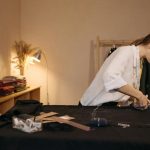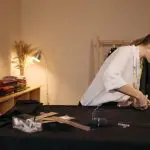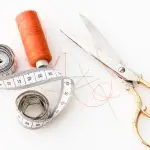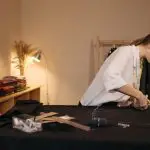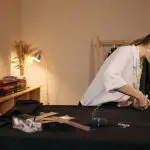You're ready to tackle that worn-out armchair, but do you have the right tools for the job?
Mastering upholstery requires the right equipment, and we've got you covered with the 10 essential tools you need.
From a trusty staple remover to durable fabric shears, each item plays a crucial role in transforming your furniture.
And of course, no upholstery project is complete without a needle and thread.
Whether you're a seasoned pro or just starting out, having these tools at your disposal will make your upholstery endeavors a breeze.
So, grab your gear and get ready to breathe new life into your favorite furniture pieces!
Key Takeaways
- Proper technique and the right tools are essential for staple removal and tack pulling, such as claw-style and plier-style staple removers and sturdy tack pullers.
- High-quality fabric shears are crucial for achieving precise and smooth cuts in upholstery fabric, and proper maintenance is important for preserving their cutting edge.
- Upholstery hammers and staple guns are necessary for securing fabric and trim to furniture frames, and regular maintenance ensures their effectiveness.
- Using the right sewing machine accessories, such as presser feet and needles, and selecting the appropriate thread thickness and color are crucial for professional-looking upholstery projects.
Staple Remover
When you begin reupholstering furniture, start by removing the old staples with a sturdy staple remover. Proper technique is essential to avoid damaging the furniture or injuring yourself. Position the staple remover under the staple and apply even pressure to pop the staple out. Be careful not to tear the fabric or scratch the furniture while removing the staples. There are different types of staple removers available, including the claw-style remover and the plier-style remover.
The claw-style remover is ideal for larger staples, while the plier-style remover provides better precision for smaller staples in tight spaces. Understanding the proper technique for using each type of staple remover is crucial to achieving a clean and smooth removal process. The claw-style remover requires a firm grip and even pressure to avoid slipping and causing damage. On the other hand, the plier-style remover offers better control and accuracy, making it suitable for delicate fabrics and intricate designs.
Mastering the use of these different types of staple removers will significantly improve your reupholstering skills and help you achieve professional results.
Fabric Shears
You'll need a pair of sharp fabric shears to accurately cut through upholstery fabric and achieve clean edges for your reupholstering project. When it comes to fabric cutting, investing in high-quality fabric shears is crucial for achieving precise and smooth cuts. Here's why they're essential:
- Sharpness: Quality fabric shears are designed to maintain their sharpness, allowing you to effortlessly cut through thick upholstery fabric without fraying or damaging the material. Regular maintenance, such as sharpening and proper storage, is essential to preserve their cutting edge.
- *Fabric Maintenance*: Proper maintenance of fabric shears is essential to ensure their longevity and performance. After each use, wipe the blades clean and store them in a protective case to prevent them from dulling or rusting. Additionally, periodic sharpening by a professional will help maintain their precision.
In the realm of upholstery, fabric shears are indispensable tools for achieving clean and accurate fabric cuts. By prioritizing their sharpness and implementing proper maintenance, you can ensure that your fabric shears remain effective for your reupholstering endeavors.
Upholstery Hammer
To properly secure fabric and trim during upholstery, you'll need a sturdy upholstery hammer. Upholstery hammers are essential for ensuring that fabric and trim are tightly and securely fastened to furniture frames. When using an upholstery hammer, it's crucial to employ proper techniques to achieve professional results.
One key technique is to hold the hammer at a slight angle when striking the upholstery tacks or nails, which helps to ensure they're fully driven into the frame. Additionally, using controlled and precise strikes with the hammer will help prevent damage to the fabric or trim.
Caring for your upholstery hammer is also important to maintain its effectiveness. Be sure to regularly inspect the hammer for any signs of wear or damage, and replace it if necessary. Keep the hammer clean and free of any debris that could scratch or snag fabric. Storing the hammer in a dry environment will help prevent rust and corrosion, prolonging its lifespan.
Tack Puller
An essential tool for upholstery is a sturdy tack puller that allows you to efficiently remove upholstery tacks and nails without causing damage to the furniture frame or fabric. When using a tack puller, it's important to employ proper technique and consider modern alternatives for optimal results.
- Tack Puller Technique
- Grip: Hold the tack puller firmly but without exerting excessive force to maintain control and prevent slipping.
- Angle: Position the tack puller at a slight angle under the tack or nail to ensure optimal leverage for smooth removal.
- Tack Puller Alternatives, Modern Solutions
- Electric Tack Puller: Consider using an electric tack puller for larger upholstery projects, as it provides efficient and precise tack removal with minimal effort.
- Magnetic Tack Puller: Explore the option of a magnetic tack puller, which simplifies cleanup by attracting and holding onto removed tacks and nails.
Staple Gun
Using a staple gun, securely fasten the upholstery fabric to the furniture frame by pressing the trigger and positioning the staples at regular intervals along the edges.
To ensure the staple gun's effectiveness, regular maintenance is crucial. Keep the staple gun clean and free of debris, and regularly lubricate its moving parts to maintain smooth operation. Additionally, check for any loose or damaged parts that may affect the stapling process.
When it comes to choosing the right staples, consider the thickness of the fabric and the furniture frame. For thicker fabrics or hardwood frames, heavier-duty staples are recommended to provide a secure hold. Conversely, lighter fabrics and softer woods require lighter staples to prevent damage. It's essential to select staples that are compatible with your specific staple gun model to ensure proper functioning.
Webbing Stretcher
When upholstering furniture with a staple gun, you can enhance the process by incorporating a webbing stretcher to ensure proper tension and support for the upholstery fabric. A webbing stretcher is an essential tool for achieving professional results in upholstery projects. Here's why:
- Webbing Maintenance and Stretching Techniques
Proper maintenance of webbing is crucial for the longevity of upholstered furniture. A webbing stretcher allows you to tighten and adjust the webbing, preventing sagging and ensuring that the fabric sits smoothly.
Different stretching techniques can be applied using a webbing stretcher, such as the zig-zag method, to evenly distribute tension across the webbing, resulting in a sturdy foundation for the upholstery.
- Webbing Material and Durability Factors
The type and quality of webbing material used can significantly impact the durability of the furniture. A webbing stretcher helps in testing the resilience of the webbing material and ensures that it can withstand the expected load and usage.
Sewing Machine
You frequently rely on a sewing machine to securely attach fabric and create precise seams when upholstering furniture, ensuring a professional and durable finish. To keep your sewing machine running smoothly, regular maintenance is essential. Clean the machine after each use, oil it according to the manufacturer's instructions, and change the needle regularly to prevent snags and ensure smooth stitching. Troubleshooting common issues such as thread tension or jamming will also help you maintain a consistent stitch quality.
In addition to maintenance, utilizing the right accessories and attachments can enhance your sewing machine's capabilities. Invest in a variety of presser feet, such as a zipper foot or a walking foot, to tackle different upholstery tasks with ease. A heavy-duty needle plate and feed dog can also provide more stability when working with thick upholstery fabrics. Understanding how to properly attach and use these accessories will expand your sewing machine's versatility and improve the quality of your upholstery projects.
Upholstery Needles
When it comes to upholstery needles, it's important to consider the different types available and how they suit various fabrics and projects.
You'll also want to think about the thickness and material of the thread you'll be using with each needle.
Understanding these points will help ensure you have the right tools for the job and achieve professional-looking results in your upholstery projects.
Different Needle Types
As you explore upholstery projects, it's important to familiarize yourself with the various types of needles used specifically for upholstery work. When it comes to upholstery needles, there are several types and sizes to consider, each designed for specific tasks.
Here are some key aspects to keep in mind:
- Types of Needles
- Straight Needles: Ideal for basic stitching and general upholstery work.
- Curved Needles: Perfect for tasks that require sewing in tight spaces or working with awkward angles.
Understanding the material and strength of the needles is crucial for achieving professional results. By selecting the right needle type and size based on the specific upholstery project, you can ensure efficient and high-quality stitching.
Thread Thickness and Material?
Understanding the material and strength of the needles is crucial for achieving professional results when selecting the appropriate thread thickness and material for your upholstery project.
Thread durability is essential for upholstery, as it ensures the longevity of the finished product. When choosing thread thickness, consider the fabric type and the stress the upholstery will endure. For heavier fabrics or high-traffic areas, opt for thicker, more durable threads.
Additionally, needle size plays a critical role in material compatibility. The needle should be large enough to accommodate the thread without causing damage to the fabric.
It's also important to consider color options when selecting thread, ensuring it complements the upholstery fabric.
Upholstery Thread
To choose the right upholstery thread, assess the fabric's weight and the stress the upholstery will endure. The thread tension is crucial to ensure the stitches hold up under pressure. Consider the following when choosing upholstery thread:
- Thread Tension Importance
- Adjust the tension of the thread to match the fabric's weight and the stress the upholstery will endure. Use a heavier thread and lower tension for thicker fabrics and high-stress areas, and a lighter thread with higher tension for lighter fabrics and low-stress areas.
- Thread Color Matching Techniques
- Match the thread color to the fabric by holding the thread against the fabric in natural light. Choose a thread color that blends seamlessly with the fabric, especially for upholstery that's highly visible. For patterns, select a thread color that matches the background color to maintain a cohesive look.
Considering thread tension and color matching techniques will ensure that your upholstery not only withstands stress but also looks professionally finished.
Pliers
Use a sturdy pair of pliers to firmly grip and pull staples or nails from the upholstery frame. When using pliers for upholstery work, it's essential to employ proper technique and maintenance for optimal results.
Pliers Technique Best Practices
Here are some best practices for using pliers effectively in upholstery work:
| Technique | Description | Benefits |
|---|---|---|
| Firm Grip | Ensure a strong hold on staples or nails | Prevents slippage and damage |
| Proper Angle | Position pliers at a suitable angle | Facilitates easy extraction |
| Controlled Force | Apply consistent and controlled force | Minimizes damage to frame |
| Precision | Grip staples or nails close to the frame | Reduces risk of breakage |
| Smooth Movement | Pull staples or nails in a steady motion | Prevents unnecessary strain |
Pliers Maintenance Tips and Tricks
To keep your pliers in optimal condition, consider the following maintenance tips:
- Regularly clean and oil the pivot point to ensure smooth operation.
- Inspect the teeth for wear and replace worn-out pliers promptly.
- Store pliers in a dry place to prevent rust and corrosion.
- Avoid using pliers for tasks beyond their capacity to prevent damage.
Frequently Asked Questions
What Are the Different Types of Upholstery Needles and When Should Each Type Be Used?
When choosing upholstery needles, consider the types: straight for basic sewing, curved for tufting, and round for leather. Use larger sizes for thicker fabrics. Choose strong thread like nylon or polyester for durability.
Can I Use Regular Thread for Upholstery Projects or Do I Need Special Upholstery Thread?
Yes, you can use regular thread for upholstery, but it's better to use special upholstery thread for its strength. Upholstery thread is thicker and more durable, making it suitable for sewing machine or hand stitching and tacking techniques.
Are There Specific Techniques for Using a Tack Puller Effectively?
To use a tack puller effectively in upholstery, ensure proper usage by positioning the tool at a slight angle under the tack. Apply gentle pressure and leverage to lift the tack from the fabric without causing damage.
How Do I Choose the Right Type of Webbing Stretcher for My Upholstery Project?
When choosing the right webbing stretcher, consider the type of upholstery fabric and the project size. Proper tack puller techniques involve using it at a low angle to prevent damaging the fabric. Always practice on scrap material first.
Can I Use a Regular Sewing Machine for Upholstery Projects or Do I Need a Special Machine?
Yes, you can use a regular sewing machine for upholstery projects, but a special machine is preferred for heavy fabrics and thick materials. It's possible to make adjustments, but a machine designed for upholstery will make the job easier.
- Does Chiffon Fabric Stink - July 15, 2025
- Does Chiffon Fabric Affect the Economy - July 15, 2025
- Does Cotton Fabric Have a Nap - July 15, 2025



